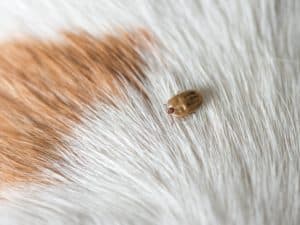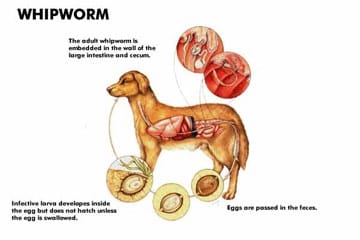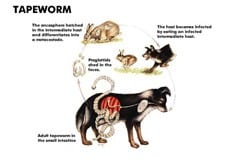Fleas and ticks can, unfortunately, find their forever homes on dogs. Preventing fleas and ticks has come a long way with topical products that can be applied as often as monthly, or oral pills that are both tasty and effective at eliminating many life stages of the flea and tick.
Here are some important facts on fleas and ticks and how to keep your pets safe from them.
What are Fleas?
Fleas are tiny parasites that require the blood meal of a mammal or bird to survive and reproduce. While they need warm, humid temperatures to thrive (our friends in the south have particularly bad flea problems), the larvae and pupa can overwinter in the house or on animals like coyotes and rabbits and their dens, extending their life cycle from several weeks to many months.
Fleas tend to hang out in the same areas that are popular with your dog and other wildlife: shady areas out of direct sunlight and direct foot traffic. The flea life cycle is complex, consisting of four stages: egg, larvae, pupa, and adult. Because some of these life stages occur off the host (your dog or cat), prevention and treatment for fleas and ticks targeted at several of these stages works best.
Flea Prevention & Treatment
First off, we want to treat the environment and make it an inhospitable place for fleas to live. Clearing brush, keeping grass cut short, and raking leaf piles are great at eliminating flea hide-outs. Inside, frequent vacuuming to stimulate egg hatching and laundering bedding daily is important if you suspect a flea infestation. Next, you’ll want to utilize one of the many products available from your veterinarian to kill adults, larvae, and eggs.
Some popular preventatives include:
Over the counter products can not only be ineffective (think flea collars), but dangerous to pets. Flea preventatives work by sterilizing the adult flea (flea birth control, if you will), others work via overstimulating the flea central nervous system. Treated hairs can also work to kill larva and eggs in the environment. Because new eggs shed into the house or yard are constantly hatching, it is important to treat consecutively every month to kill emergent fleas. An adult flea can produce 500 eggs in just a few weeks!
A flea comb can be utilized to find live fleas on your dog, though most pet owners aren’t fast enough to catch a hopping flea. Tell-tale signs of a flea problem are itching or biting near the tail base and evidence of a black pepper-like granule (flea poop) in the fur that turns reddish on a damp paper towel. That red coloration is digested blood. Fleas can cause an allergic response to their saliva in some dogs; one bite can cause severe hair loss and scratching. A heavy infestation can lead to low red blood cell count, transmission of tapeworms, or diseases such as the plague or typhus.
How Are Ticks & Fleas Different?
Similarly, ticks love to live in outdoor areas such as wood piles, yard clippings, or attached to hosts such as mice and deer. True opportunists, they wait to attach to an unsuspecting mammal as they brush past. Ticks become most active as the temperatures rise above freezing. This fools many dog owners into thinking they can forgo preventatives from December to March. Ticks don’t typically leave tiny poop calling cards like fleas. Many times, they are not discovered on your dog until they have been attached for days to weeks and are engorged with blood.
Ticks also have a four-part life cycle, and other than the egg, each stage including the larva, nymph and adult needs a blood meal to survive. The complete life cycle can take two years to complete and an adult tick can produce up to 3,000 eggs. Frighteningly, the larva stage of the tick which will attach to a host animal is no bigger that the size of the period at the end of this sentence. Imagine finding that in your dog’s fur!
Ticks are tremendously dangerous to dogs and humans because they transmit devastating and sometimes hard to treat diseases. The deer tick is most commonly known for its ability to spread Lyme Disease.
Tick Prevention & Treatment
Because it takes 24 hours of tick attachment to infect a host with disease, prompt identification and removal is critical. If you spend time outdoors with your pet, do a tick check of the skin and hair coat after returning home. Ticks especially love to set up shop on a dog’s ear flaps. If you see an embedded tick…
- Grasp its head as close to the skin as possible with a pair of tweezers.
- Pull the entire tick out in one swift movement.
- It’s okay if you get a bit of dog with your tick – just clean the area with soap and water and apply a triple antibiotic ointment to the bite.
Many of the same preventatives we use for flea control are also effective at repelling and/or killing ticks during that 24-hour window of attachment. Consistent use is important and recognize if your dog is boarded or groomed, it can pick up parasites from other dogs. Yard treatments are also available to kill ticks and fleas. It’s best to consult a company that specializes in such treatment as some chemicals can be harmful to humans on pets.





